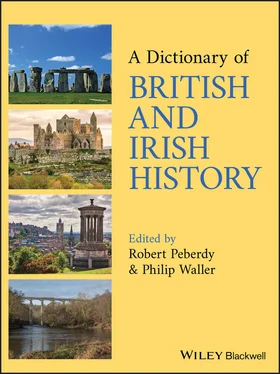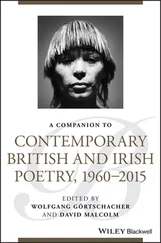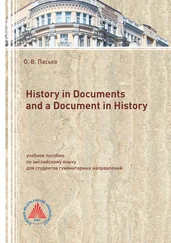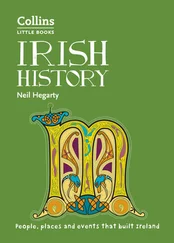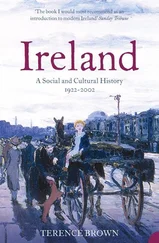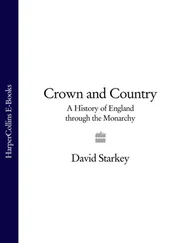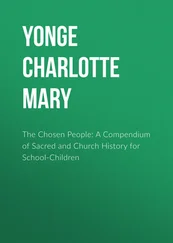In 1012 Thorkell, a Danish leader, became Æthelred's (paid) supporter. Denmark's king, SWEIN FORKBEARD, probably fearing attack, made a pre‐emptive invasion (summer 1013). Æthelred fled to Normandy (Dec. 1013). Swein's death (Feb. 1014) enabled him to return, but Swein's son CNUT invaded (1015) and quickly conquered much of England. Æthelred died in early 1016, leaving his son EDMUND IRONSIDE to continue resistance.
Æthelred (meaning ‘noble counsel') was nicknamed Unræd (OE, meaning ‘no‐counsel' or ‘ill‐advised’) from the 12th century. This was later corrupted to ‘Unready'. See also GELD.
ÆTHELWOLD(b. between 904 and 909 at Winchester, Hampshire, Wessex; d. 1 Aug. 984 at Beddington, Surrey, England, aged around 78). A monk at Glastonbury under DUNSTAN, c.954 Æthelwold was given the MINSTER at Abingdon (modern Oxfordshire) where he created a Benedictine monastery. As bishop of WINCHESTER (from 963) he extended monastic reform, replacing clergy at the Old and New Minsters with Abingdon monks and refounding religious houses elsewhere (e.g., Peterborough, Ely). He consolidated reform by compiling the Regularis concordia (‘Monastic agreement', early 970s), a rule for English religious houses based on St Benedict's rule. Æthelwold also promoted liturgical change, and was an important adviser to the young King ÆTHELRED II. See also TENTH-CENTURY REFORMATION. ÆTHELWULF
(fl. from 825; d. 858). Æthelwulf succeeded his father EGBERT as king of WESSEX (S England) in 839 after ruling subordinate territories (SE England) as subking. (His son Athelstan succeeded as subking.) From the 840s Wessex suffered frequent VIKING (Danish) raids. Æthelwulf won a famous victory in 851, reported even in Francia.
In 855–6 Æthelwulf made a pilgrimage to Rome. During his absence, his son Æthelbald rebelled (856). On return, Æthelwulf had to cede much of Wessex to Æthelbald. See also KINGSHIP, ANGLO‐SAXON; ALFRED.
AFFINITYsee BASTARD FEUDALISM AFGHANISTAN, BRITISH RELATIONS WITHThe aim of British policy in the 19th century was to exclude Russian influence from Afghanistan as a buffer state to protect India (see GREAT GAME). The First Afghan War (1838–42) involved a British attempt to restore a pro‐British ruler. The Second (1878–80) forcibly installed a British envoy at Kabul who was promptly murdered. Lord ROBERTS then briefly occupied Kabul and relieved a garrison near Kandahar (1879–80). After another conflict, Britain recognized the independence of Afghanistan by the treaty of Rawalpindi (Aug. 1919). Britain again undertook military operations in Afghanistan in the early 21st century as part of the US‐led ‘War on Terror’ (see AFGHANISTAN WAR (2001–14), BRITISH INVOLVEMENT). See also RUSSIA AND USSR, ENGLISH AND BRITISH RELATIONS WITH; ANGLO‐RUSSIAN CONVENTION. AFGHANISTAN WAR (2001–14), BRITISH INVOLVEMENT
After hijackers associated with the radical Islamic group al‐Quaeda crashed three passenger aircraft into prominent buildings in the USA on 11 Sept. 2001 (called ‘9/11’ in USA), the USA intervened in Afghanistan, hunting al‐Quaeda’s leader Osama bin Laden. Afghanistan was dominated by the Taliban, a fundamentalist Islamic movement. Working with anti‐Taliban forces, the USA drove the Taliban from government (Oct.–Dec.), though bin Laden remained at large (killed in Pakistan in 2011). US and international forces stayed in Afghanistan to eliminate terrorist bases and promote democratic society, but were challenged by resurgent Taliban until 2009, when a ‘surge’ (deployment expansion) again repulsed them. Combat operations formally ceased in Dec. 2014.
British forces participated from the start with missile attacks (7 Oct. 2001). Troops were deployed from Nov., and joined ‘ISAF’ (International Security Assistance Force), a force authorized by the United Nations (Dec.) to train Afghan forces (police, army) and fight insurgents. From summer 2006 Helmand Province in S Afghanistan (population 880,000) was the main area of British activity, starting with 6000 troops who were tasked to suppress Helmand’s opium industry (responsible for 80% of world production). Some economic and social development work occurred, but forces were mostly involved in military operations. By 2009 Britain’s Helmand deployment exceeded 9000 troops. Extra US forces were then introduced (2010), and a British withdrawal began (2011). It ended in Oct. 2014, leaving a small training force. British forces suffered 456 deaths. See also UNITED STATES OF AMERICA, BRITISH RELATIONS WITH; BLAIR, TONY.
AFRICAN CARIBBEANS IN GREAT BRITAIN
A few immigrants from English (later British) colonies in the WEST INDIES settled from the 17th century. During the 19th century small communities became established in ports (e.g., LONDON, CARDIFF, LIVERPOOL).
Large‐scale immigration, predominantly from JAMAICA, began in 1948, symbolized by arrival of the ship Empire Windrush carrying 492 Jamaicans. By the early 1960s, there were about 300,000 African Caribbean immigrants, who sought a better life. Settled mainly in cities, they remained the largest minority group until the late 1970s. Though westernized, English‐speaking and often Christian, they encountered discrimination in public housing and employment (e.g., exclusion from employment on buses in BRISTOL, provoking the ‘Bristol bus boycott’ in 1963). Disturbances occurred in African Caribbean areas (late 1950s–mid 1980s; e.g., NOTTING HILL RIOTS, 1958, BRIXTON AND TOXTETH RIOTS, 1981).
Numerous African Caribbeans became prominent in sport and music, and ‘countercultures’ flourished. A majority of African Caribbean families have been single‐parent households, usually headed by a mother. By the early 21st century, African Caribbeans were the fifth‐largest minority (about 600,000 in 2011, mostly in England and Wales). High levels of intermarriage or cohabitation took place mainly with the white population. See also ETHNIC AND NATIONAL MINORITIES, ENGLAND/WALES.
AFRICANS IN GREAT BRITAIN
A few black Africans lived in England from the mid 16th century, often originating from the SLAVE TRADE and working as personal servants. By the 18th century, there were possibly 15,000 in LONDON. (Slavery was not recognized in England and Wales, as Somerset’s case confirmed in 1772.)
In the 1960s–70s, thousands of black Africans from former British colonies in WEST AFRICA settled, many coming initially as university students. Continuing immigration from sub‐Saharan countries expanded rapidly from the later 1990s, from former British territories (e.g., Zimbabwe) and elsewhere (e.g., Congo). In 2011 there were 1,016,000 black Africans in Britain, of whom two‐thirds lived in London and most of the remainder in other cities and towns in England and Wales. About 25% of men and 18% of women married or cohabited outside their own group (2010).
From the late 1980s African immigrants included refugees from civil war in Somalia – some from former BRITISH SOMALILAND, most from former Italian Somaliland. As Muslims from rural backgrounds, with a clan‐based social structure and often illiterate, Somalis tended to form exclusive communities. With only 30% of adults employed, they depended extensively on State benefits. About 60% of households were headed by a single parent. The few Somalis who prospered included the champion runner Sir ‘Mo’ Farah (b. 1983 in Somalia). In 2011, there were about 103,000 Somalis (two‐thirds resident in London). See also ETHNIC AND NATIONAL MINORITIES, ENGLAND/SCOTLAND/WALES.
AGADIR CRISISA dispute provoked by France’s military occupation of Fez, the capital of Morocco (NW Africa), in May 1911 (to suppress riots), effectively establishing a PROTECTORATE. France’s action threatened a Franco‐German agreement concerning interests in Morocco (1909). Germany responded by stationing a gunboat off the Moroccan port of Agadir (1 July). Great Britain’s chancellor of the Exchequer, David LLOYD GEORGE, publicly supported France (21 July), to Germany’s consternation. Britain’s stance reinforced the ANGLO‐FRENCH CONVENTION (1904) and raised tension with GERMANY. The matter was settled by negotiations. See also GREY, EDWARD; GUNBOAT DIPLOMACY. AGINCOURT, BATTLE OFsee HUNDRED YEARS WAR AGREEMENT OF THE PEOPLEA proposed radical constitution for England and Wales which was drawn up by LEVELLERS in the NEW MODEL ARMY and presented to the Army’s Council on 28 Oct. 1647, following the First CIVIL WAR (see PUTNEY DEBATES). Parliament would have full powers and be elected by an extensive franchise. There would also be religious toleration. Two further versions were published and, while uninfluential at the time, they affected later radical thinking. See also CIVIL WARS, POLITICAL ASPECTS. AGRICOLA(b. 13 June 40 at Forum Julii/Fréjus, SE Gaul; d. 93 at Rome, Italy, aged about 53). A distinguished Roman senator, Gnaeus Julius Agricola owes his fame to a biography by his son‐in‐law TACITUS. After an early career which included two postings in Britain (c. 61, 70–3 or 74), Agricola was consul in 77. As governor of Roman Britain (77–83) he completed the conquest of W Britain (Wales) and advanced into N Britain (Scotland), defeating the CALEDONIANS at MONS GRAUPIUS (83). See also ROMAN BRITAIN. AGRICULTURAL CO‐OPERATIVES, IRELANDSocieties formed from 1889 mainly by farmers to improve efficiency. Following Continental European models, co‐operatives operated creameries for butter production, bought seeds and fertilizers in bulk, marketed produce, and provided credit. The movement was promoted by the Irish Agricultural Organisation Society, founded 1894 (see PLUNKETT, HORACE). By 1914 there were about 1000 societies. In the later 20th century, many became large businesses through mergers. See also AGRICULTURE, IRELAND 17TH CENTURY TO 1921. AGRICULTURAL DEPRESSION, LATE 19TH CENTURYFrom the late 1870s, AGRICULTURE in Great Britain and Ireland suffered from a substantial decline in food prices and profitability caused by the influx of cheaper foreign foodstuffs. Wheat producers (e.g., in S England, SE Scotland) were worst hit, undercut by US and Russian wheat. Livestock producers were affected by American chilled beef (from 1875) and by Australian and New Zealand frozen meat (from 1880). Many left farming; landlords lost rental income. The depression encouraged dairying and diversification, and in Ireland contributed to LAND AGITATION. Conditions improved slowly from c.1900. See also FOREIGN TRADE, GREAT BRITAIN FROM LATER 18TH CENTURY. AGRICULTURAL REVOLUTION
Читать дальше
